New
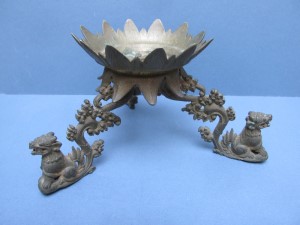
Very rare object, used during holy water rituals on Bali. The Hindu priest will create holy water by handgestures (mudra's) and uttering texts (mantra's). The container with holy water is placed on the tripada.
Please click on the photo for more photos-info.
1850-1900
|
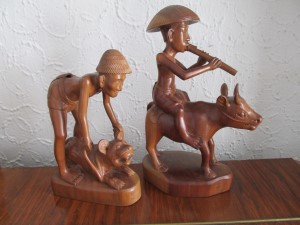
Wooden statues from the mountain village Sebatoe on Bali
1940-1960
These two small woodcarvings were not made for the tourist market but pure folk art. The Sebatoe carvings are meant to be humorous and entertaining, and are carved for fun.
The subjects are often funny observations from the daily life in a village. Often with phantasy animals and/or persons.
Although the Sebatoe carvers made them for fun, the level of artistry is high, which is clearly reflected in these two pieces.
|
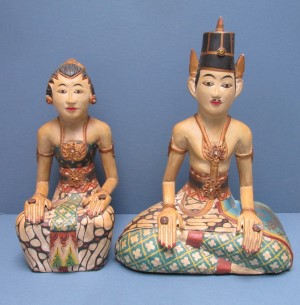
Colored wooden pair of carvings of an ideal married couple or Loro blonyo from Java.
Pls click on the photo for more photos&info
1940-1950
For many years I was looking for a loro blonyo which was not made for the tourist market with a certain degree of quality.
Most of the loro blonyos are either broken or of inferior quality.
This pair has a decent painting quality and is mint.
What struck me immediately was the juwelry. They are refined with real stones on various places of the body. The previous owner told me they were acquired somewhere in the 1940s.
On the site of the museum for wereldculturen you can read that the excistence of those juwelry means that the couple is of a higher caste.
Also the person who sits at the right is higher in caste than the other one.
|
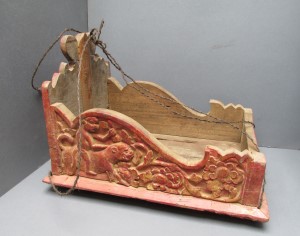
Offering container for new born children. Local name; Sanggah Kumara. Made of wood and rope. Bali, around 1900.
1880-1900
Extremely rare object. This antique offer tray was used to hang above a new born child at the ceiling. That is why the bottom has been carved with the child god Kumara for protection. Inside the tray offers were placed in order to protect the child from evil forces. Such offers could be flowers which colours are white, red, yellow and blue representing the various wind directions. This kind of object is only to be found in musea and private collections. A similar object can be seen on the last photo. Pls click on the photo to get more info and photos.
|
New

Silver modesty plate or Jempang from Sulawesi, Toraja land.
Worn by young children to cover the private parts.
1910-1940
This Jempang is much bigger than the usual Jempang. See the last photo.
It raises the question whether this seize was made for somewhat older children.
|
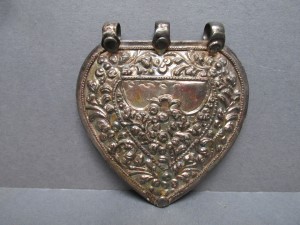
Pubic plate worn by young children in the Dutch Indies before 1940. Local name; Jempang
1930-1940
|

Pubic plate worn by young children in the Dutch Indies before 1940. Local name; Jempang
1930-1940
|

Pubic plate worn by young children in the Dutch Indies before 1940. Local name; Jempang
1930-1940
|
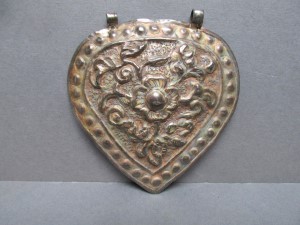
Pubic plate worn by young children in the Dutch Indies before 1940.
Local name; Jempang
1930-1940
|
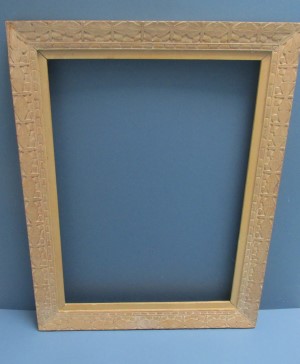
Manual carved wooden frame from Bali with butterfly motiv
1930-1940
This frame shows the creativity of the Balinese; even a frame gets a rare motiv.
This butterfly pattern is rare.
|
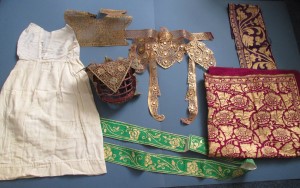
Complete dance costume of a Balinese legong dancer. Prewar
1900-1940
Well preserved costume.
This costume was sent to an English dance institution, where they studied the various Asian dances.
Including the original dance crown and dance fan.
In 1936 a book was published "Temple dances of Bali" by the Swedish artist Tyra Kleen, which shows the various costumes of the legong-dance.
Please click n the the photo for more photos and info.
|
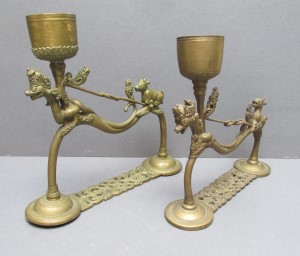
Set of 2 incense burners, used by the Hindu priest on Bali during ceremonies or rituals. Local name; Padamaran
1900-1950
This burner is used by the Pedanda, the Balinese priest, to help him perform certain rituals during ceremonies, like tooth filing, marriage or the blessing of a temple.The two figures are the naga, the holy snake ,at the front, and the nandi at the back. Nandi is the travel animal of Shiva.
The last three photos show a priest performing a ritual with the padamaran in the right hand.
Collectors item.
Pls click on the photo to get more info and photos.
|

Coloured sirih container from Bali or Lombok
1950-1970
Nicely coloured box to save the sirih durng travelling.
Real folk art.
|
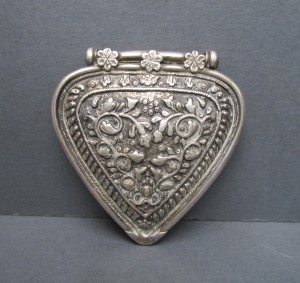
Pubic plate worn by little girls in prewar Indonesia.
Lacal name jempang
1900-1950
Early small plate from Bali or Lombok. Decorated with several motivs.
Balinese silver.
These plates were used by naked little girls. There are pubic jewelery for boys as well.
In Atjeh some of the pubic plates are made of gold decorated with detaied filigrain. Those rare golden plares are locally called; Cuping
|

Wooden rice beater from Bali. Local name; panaptapan
1900-1950
Antique object from the Bali before 1950. These ricebeaters were used after the harvest to flatten the top surface of a bundle rice arens, before these bundles were taken to the rice barns. The use of these ricebeaters stopped when new types of rice were introduced in Bali around 1970. On one side of the ricebeater an image of Dewi Sri, goddess of the rice, has been carved. No doubt to ensure a rich harvest. Pls click on the photo for more photos and info.
|
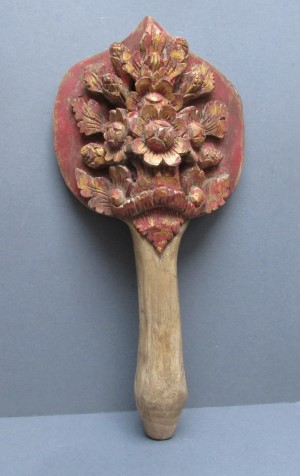
Wooden rice beater from Bali. Local name; panaptapan
1900-1950
Antique object from the Bali before 1950. These ricebeaters were used after the harvest to flatten the top surface of a bundle rice arens. The use of these ricebeaters stopped when new types of rice were introduced in Bali around 1970. This ricebeater has a flower pattern as decoration and the handle is carved in the shape of a turtle.
Folk art!
Pls click on the photo for more photos and info.
|

Bali ashtray
1950-1970
This ashtray is made of a base metal.
At the inside there is an image of a Djanger dancer.
This item was solely made for the tourist market.
|

Painted cow bell
1950-1970
ToboArt tries to show non-commercial items, but this lovely painted cow bell is an exception. It was made in the 1950s, and collected by a Dutch pilot, who bought art around the world.
The bell is decorated with Ramayana figures. The real cow bell is much bigger and usually not so elabourately painted as this one.
The last two photos show two examples of non-commercial bells from the 1930s.
Pls compare.
|

Two small silver containers to contain the umbilical cord, worn by newly born children.
1900-1930
In these small containers the umbilical cord of the newly born child is contained. Because the Hindu people on Bali believe that a newly born child is a reincarnation of one of their grand parents, everything aroud the birth is sacred. That's why the umbilical cord is saved and for the child to wear during its first year, to provide protection and good luck.
|
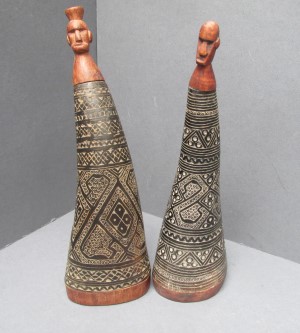
Sirih containers from Timor
1920-1940
These sirih containers are made of horn and have a wooden cover.
|
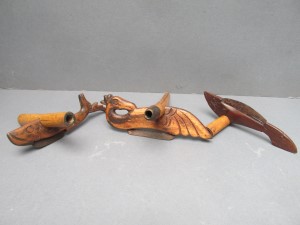
Rice cutters from Bali or Lombok. Local name; anggapan
1930-1970
Simply made rice cutters.
The holder has been carves in the shape of an animal; here a deer, fish and a phantasy animal.
|
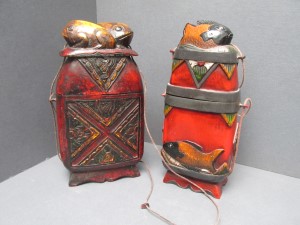
Two wooden containers to hold sirih or medicin. Bali or Lombok
1930-1960
Good example of folk art.
Nicely decorated with animals figures.
|
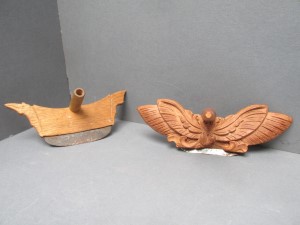
Rice cutters from Bali or Lombok. Local name; anggapan.
1900-1950
Ricecutters in the shape of a bird were quite common in prewar ndonesia.
|
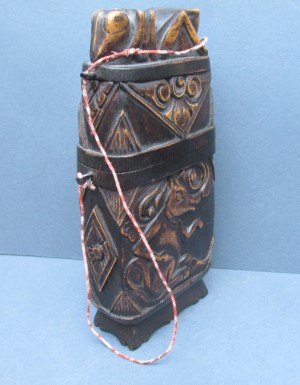
Small wooden medicin or sirih container from Bali or Lombok
1940-1970
Good example of folk art.The lid is decorated with a grasshopper, and the box is decorated with phantasy animals.
|
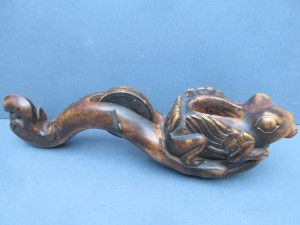
Toy from Bali or Lombok
1950-1970
The little ball is attached to a rope, and the rope to a katrol. When the ball is pulled out at a wide enough distance, the ball now needs to jump into the little gap on top. Hereby takes the player the toy at the back side and tries to flip the toy upwards. The wider the cord is pulled out, the more difficult it becomes to get the ball into the hole.
|

Model boat made of brass.
Palembang, Sumatra, made before 1940.
1920-1940
Big size model. Unclear whether this was made for the tourist industry or for the local market.
The Tropen Museum in Amsterdam has a similar prauw in the collection.
|

Old Wayang lamp holder from Bali
1920-1950
This wooden Wayang-lamp is in fact a vertical holder for an oil-lamp used during a Wayang-kulit performance.
Attached to the two holes at the bottom is a small oil-reservoir, in which a fuse is set on fire. The flame enlightens the wayang kulit puppets which are handled by the dalang behind a screen.The spectators in front of the screen see only the shadows of those puppets.
The upstanding wooden holder has the shape of a fable animal with a human face as a balinese dancer.
Pls click on the photo to get more info and photos.
The additional photos show other lamp holders and some info from the book "WAYANG ON BALI" written by Hedi Hinzler(1975).
|

Prewar Balinese knife used to cut the rice plants
Local name; anggapan
1900-1930
Very old and used rice cutter.
These cutters were used on Java, Madura and Bali.
Depending on the wealth of the user the cutter could be simple, but also display decorations, like stylish birds.
The Tropen Museum in Amsterdam has many cutters in its collection, but only one where the bamboo piece is placed straight through the handle. Considering the simularity between that one and the ToboArt piece, it is likely that both cutters originate from the same location on Bali; Tenganan, Karang Asem,Bali.
The last photo depicts a Javanese girl just after her work in the field, with her rice cutter in her hair.
|
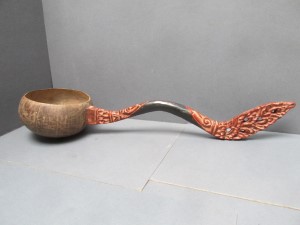
Water scoop with a handle decorated with ornaments. Prewar. Very rare object.
Local name; Gayung
1910-1940
Rare water scoop from prewar Bali. A coconut has been cut in half to create the container for the water. Sometimes in prewar bali even simple household objects, like this one, are decorated with carved motivs.
The last photo depicts a Balinese girl with a typical ordinary water scoop. The photo was taken around 1930.
Pls click on the photo to get more info and photos.
|
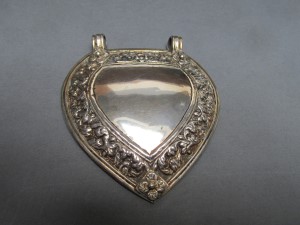
Silver pubic plate from Bali, lombok or Sumatra.
Local name; Jempang
1910-1950
Nice and mint pubic plate made of silver, wich was used by young children until the age of 8. Possible locations of origin are Bali, Lombok or Sumatra(Atjeh).
Collectors item.
|
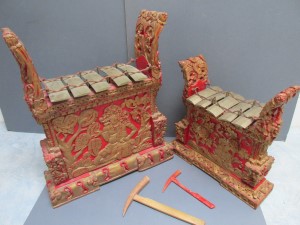
Part of the Gamelan orchestra. This instrument is called a gender, which is a general name for such a metallophone. The metal plates will resonate with the air in the underlying bamboo poles underneath and subsequently sound is produced. An hammer with a rubber head is used to play the gender. The colour red is often associated with extra-natural powers and the colour gold radiates richdom.
1950-1970
Two gamelan instruments with beautiful sonor sound.
Special attention to the detailed woodcarving!
Pls click on the photo to get more info and photos.
|
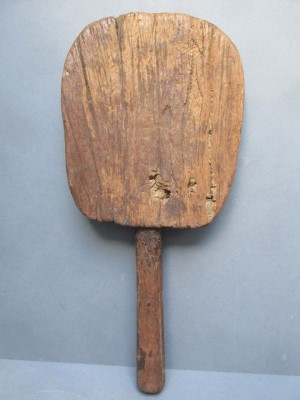
Wooden rice beater, Bali, first half 20th century
Local name; panaptapan
1900-1940
Antique object from the Bali before 1900. These ricebeaters were used after the harvest to flatten the top surface of a bundle rice arens. The use of these ricebeaters stopped when new types of rice were introduced in Bali around 1970.
Probably belonging to a simple Balinese rice farmer; other rice beaters may have a decorated side, and in some cases even a handle carved in the shape of an animal, like a turtle!
|
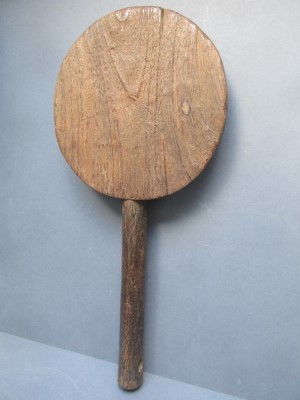
Wooden rice beater, Bali, first half 20th century.
Local name; Panaptapan
1900-1940
Very old ricebeater.
These ricebeaters were used after the harvest to flatten the top surface of a bundle rice arens. The use of these ricebeaters stopped when new types of rice were introduced in Bali around 1970. Other rice beaters may have a decorated side, and in some cases even a handle, carved in the shape of an animal, like a turtle!
|
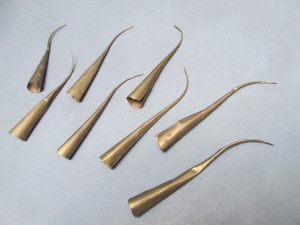
Finger extensions used in the Indonesian dance
1950-1970
Finger extensions used in the topeng dance. Made of copper. Rare
|

Wooden ricebeater from Bali. Local name; panaptapan.
1920-1940
Antique object from the Bali before 1940. These ricebeaters were used after the harvest to flatten the top surface of a bundle rice arens. The use of these ricebeaters stopped when new types of rice were introduced in Bali around 1970.
Probably belonging to a simple Balinese rice farmer; other rice beaters may have a decorated side, and in some cases even a handle carved in the shape of an animal, like a turtle!The colours with which the floral motivs are decorated are well preserved.
Real folk-art!
|
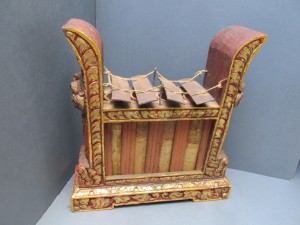
Part of the Gamelan orchestra.
This instrument is called a gender, which is a general name for such a metallophone. The metal plates will resonate with the air in the underlying bamboo poles underneath and subsequently sound is produced. An hammer with a rubber head is used to play the gender. The colour red is often associated with extra-natural powers and the colour gold radiates richdom. The kala heads on both sides of the gender are meant as protection for hostile spirits.
1930-1950
Old and antique instrument which still produces a wondeful sound.
Pls click on the photo to get more info and photos.
|
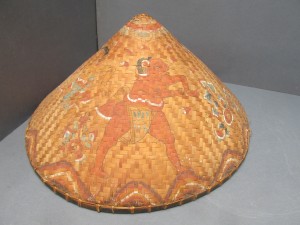
Painted Balinese spice lid made of bamboo and rotan. Local name; tutup saji
1920-1940
Rare object.
The Tropen Museum in Amsterdam has many comparable objects but only one painted.(like this item)
This bamboo lid/cover was used to keep the insects away from the food.
One can clearly see the creativity of the Balinese people in this object. No need for decoration maybe for other people, but for the Balinese important enough to paint colorful figures on this fragile cover.
|
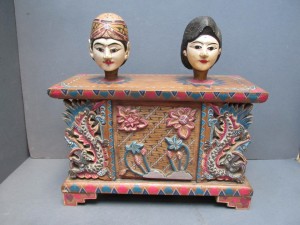
A wooden wedding altar, probably given as a present at a wedding. According to the Tropen Museum this may be a unique object; made for only one occasion.
1930-1960
I am still researching for other comparable copies.
|
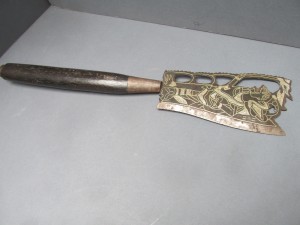
Cremation axe, used in prewar Bali at funeral rituals.
1920-1940
This axe was used during funeral ceremonies. After the body was burned, tis axe was used to cut the remaining bones in smaller pieces.
One side of the axe has a sharp ridge, the other side was used to saw the bigger parts of the skeleton.
|

Two very old rice containers used to carry rice or sirih on journeys.
As one can see on the photos both boxes have several compartments.
1900-1950
Very well possible that these rotan containers were used to carry sirih.
|

Antique rice ladle or spatula from New Ginea
1900-1940
Not clear what purpose this object had. I could have been used as a ladle or as a spatula.
|

Chalk container Batak
1930-1950
Nicely ornamented chalk container from the Batak people, Sumatra.
Bought directly from the village people, no souvenir item.
|

Container for medicin used on Sumatra
1930-1950
This container, made of horn from the buffalo, is a good example of folk art.
It was used to carry medicin on journeys. Decorated with a Wayang-figure and a frog on the lid.
|
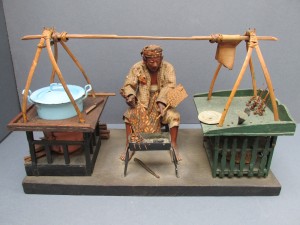
Javanese foodstand
1920-1940
Well preserved image of a Javanese foodstand, a sate seller. Before the war these sellers were abundant on the Streets of Batavia!
Pls click on the photo to get more info and photos.
|
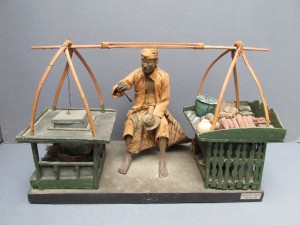
Javanese foodstand
1920-1940
Well preserved and rare marquette of a Javanese foodstand.
Materials used; wood, tin, terra cotta, bamboo, batik.
Pls click on the photo to get more info and photos.
|
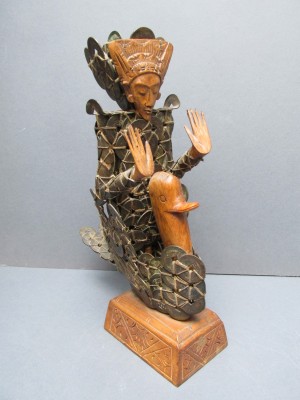
Statue made of old Chinese coins. Made on Bali
1930-1950
The rice goddess Dewi Sri on her travel-animal; the swan.
|
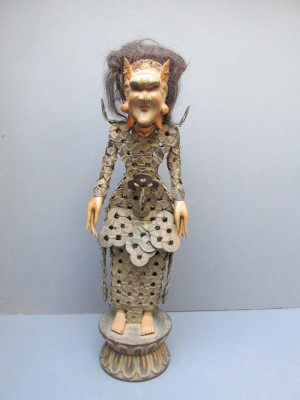
Satue made of old Chinese coins.
1930-1950
Rare coin-statue decorated with real human hair
|
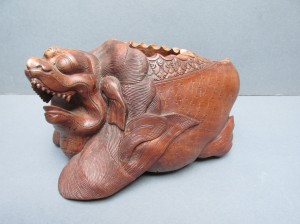
Wooden ash tray
1950-1960
|
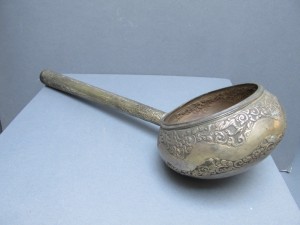
Ladle used by showering
1920-1940
Ladle with djokja patterns used during the shower(mandi) and other ceremonies on Java. The photo shows the washing of a deceased child using the ladle.
|
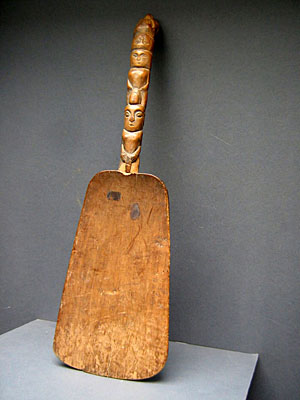
Rice ladle from Bali or Lombok
1910-1950
A rice ladle with an interesting handle. The handle has been carved as a connection between three persons(men) with an emphasis on the phallus. The last person is on top of the other two and thus is his phallus kind of protubing. Of course this all has a meaning. Probably the reason is that only a male may use this particular ladle.
|
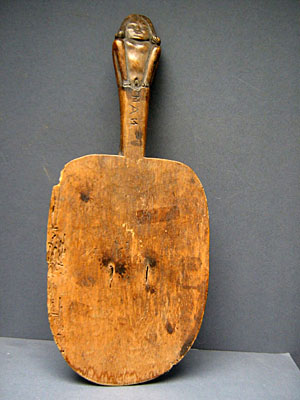
Rice ladle
This ladle has a female figure as handle. This could be an indication that this ladle was used by women only, although this could also fit another reason. Probably used in Bali or Lombok.
|

Balinese basket made of beads, dryed palm leaves and miror glass.
1930-1950
These balinese baskets were used to cover the offer items on the offer bowl
|
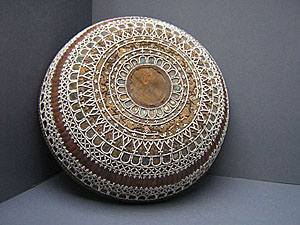
Basket made of beads and dryed palm leaves.
1930-1950
These spice lids were used to cover the offer products on the offer bowl, and to cover the food from insects.
|

Wooden offer tray
1930-1950
This painted wooden offer tray was used during temple processions and other ceremonies to carry the offer-gifts. these were made of fruits and flowers. The offerings(banten) are necessary to please the gods.
|
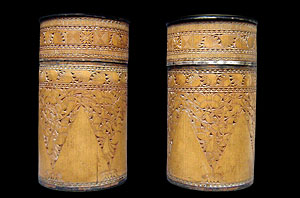
Bamboo containers Padang
1930-1950
Striking on these containers are the detailed patterns, carved in the bamboo. These ornaments are typical of the Minangkabau-people in the Padang-area (West-Sumatra). This particular pattern is described by F A Wagner in her book "Sierkunst in Indonesie" on page 87.
These containers were probably used to hold sirih.
Rare.
|

Bali mask
1950-1970
Fine carved mask by the well known maskmaker I KTUT PATUT, who worked in sebatoe. This mask was bought in the Njana-tilem gallery. Tilem was so pleased with the quality that he sold these items as they were made by him.
|

Part of the dance costume of a Legong dancer
All of these are part of the Legong-costume. They are made of cow-leather and glass and cotton.
|
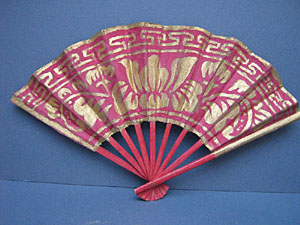
Fan used in the Legong dance
1930-1950
Old fan used by the Legong dancers. It was part of a complete Legong dance costume that ToboArt was able to acquire. Rare.
|
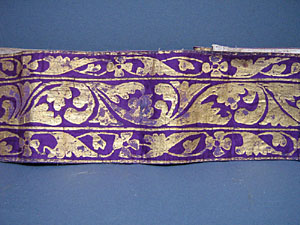
Part of the dress of a Legong dancer
1930-1940
Rare object which was used as part of the Legong-dance-costume. The cloth was wrapped up tight around the small body of the young Legong dancer. Richly decorated by bali-motives. Remarkebly well preserved. This cloth was taken to Holland by a Dutch collector just before 1940.
|
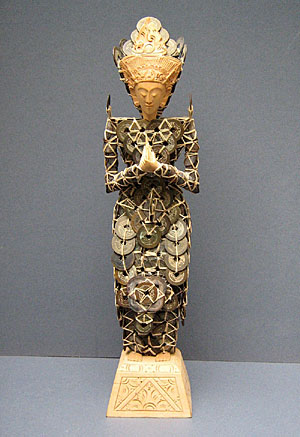
Artwork made of coins.
|
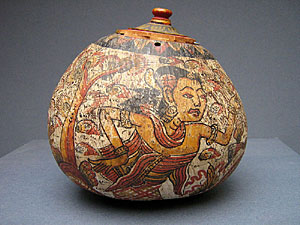
Handpainted coconut.
Probably early 20th century. There are still nicely handpainted coconuts to be found, but not the real old ones like this one, which has the pictures of the Ramanaya-story on it.
|
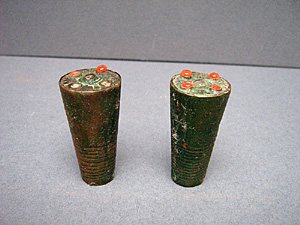
A pair of painted ear-plugs.
Local name; Subeng
1920-1930
Old ear plugs, worn by Balinese women before 1940. These were made of tin-plate and the space inside was used to store tobacco. for betel-stewing. See last photo.
|

Beautiful ashtray, wood, made in the dessa Mas, Bali.
1960-1970
During the big tourist influx in the 1960-70 all kinds of household objects were produced from wood and sometimes extensively decorated. Ashtrays were popular but also cigar- and cigarette boxes and lamp-standards. The tourist industry was making big money then. This beautiful ashtray was made in Mas by a member of the Taman-family who had a reputation of excellent woodcarvers.
|